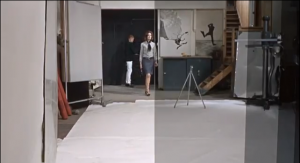Blow Up is a 1966 film directed by Michelangelo Antonioni.
In this scene note the choreography of the actors, camera, frame and focus. As covered in the lecture describe the things Antonioni would have have to consider when directing the actors and the camera.
In this scene from Michelangelo Antonioni’s Blow Up we see actors navigate space to develop their relationship and the story. As there are lot of props and location obstacles in the scene, the director would have had to choreograph the actor’s to understand their screen direction.

For example, the ceiling beams that the actors have to duck under, the director chooses to leave the camera angle in the same spot while the actors are half cut off by the beam; capturing the pair in a sanctioned off space and creating an intimate moment.
The camera follows characters when they’re moving and frames them from different angles when stationary. In the shot where the two actors talk between the beam, we see the woman pace back and forth with the camera following her, zooming in as she hits the plastic wall. This develops anxiety and annoyance for the female character.
Framing in the scene works to frame the characters separately and then together. An example is when the woman has just finished pacing and stands at the plastic screen, the man ducks under the beam and enters the space. It should be noted that whenever there is a shift of characters into space, majority of the time the man enters into the woman’s area, furthering his desire of her. In the final part of the scene the characters are framed separately as the man lights a cigarette and the woman sits not the couch, an expression of the different worlds they live.
Focus works on each actor at a particular time, however there are times where the woman is in focus as she’s closet to the camera and the man resides in the background. When directing the actors and the camera Antonioni would have considered depth of field as influenced by focus, as the actors are moving different distances away from the camera.
 Different focal lengths offer different depth of field and perspective. Camera distance in relation to depth of field is another element Antonioni would have had to think about – a short focal lense appear to exaggerate the spatial relationship between objects in depth, such as when the characters enter the main room in the man’s place; while a long focal length lense appears to compress the spatial relationship between objects in depth; for example when the the woman first walks around upstairs with the man.
Different focal lengths offer different depth of field and perspective. Camera distance in relation to depth of field is another element Antonioni would have had to think about – a short focal lense appear to exaggerate the spatial relationship between objects in depth, such as when the characters enter the main room in the man’s place; while a long focal length lense appears to compress the spatial relationship between objects in depth; for example when the the woman first walks around upstairs with the man.
Antonioni would have also had to consider perspective as many of the intercut shots are from different angles, such as the high angle when the man sits on the chair, a curious angle that almost foreshadows the unexpectedness of his dive for the telephone.

